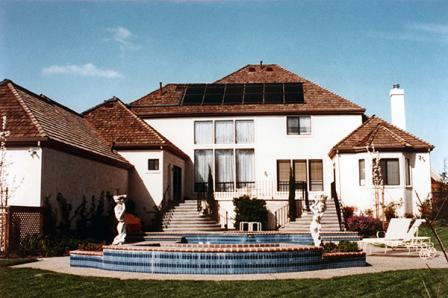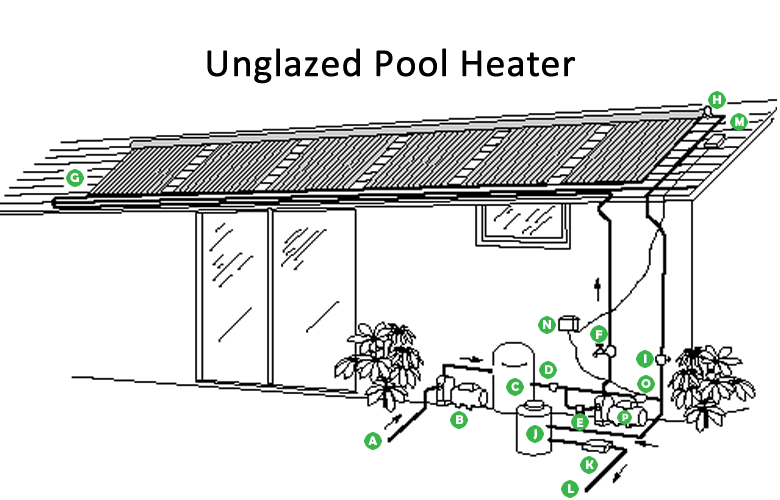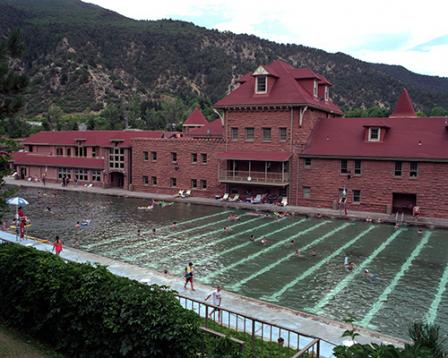Renewable Pool Heating
About Pool Heating
Pool heating can be divided into three main types:
- Domestic pool heating. Small pools, often found in the backyard of a home, can be heated with a variety of technologies.
- Commercial pool heating. Commercial pools tend to be much larger in size and heating needs.
- Cold weather warming (freeze prevention). In temperate climate zones, some pool heaters are used to keep the water just above freezing during winter months.
Although pool heating represents just a small fraction of total U.S. energy use, it can represent a substantial cost for residential, commercial, or municipal pool operators. Pool heating is also one of the easiest and most cost-effective applications of renewable technologies.
How Renewable Pool Heating Works
Renewable sources can save money and energy by pre-heating water and supplementing traditional electric or fossil-fuel heaters for pools.

Credit: Sierra Pacific Solar Rancho, NREL 08285
Renewable pool heaters come in two main forms: direct and indirect. The size of the pool and the required temperature determine which type of heater and which types of renewable technologies will be most cost-effective.
Direct heaters circulate pool water straight through a heat source, typically an unglazed solar collector. This is the simplest and most common renewable pool heating system. In general, direct pool heaters work best when the desired pool temperature is similar to the working temperature of the collector itself.
Indirect heaters have a secondary heat exchange loop between the collector and the pool, which means the original source heats another fluid, which in turn transfers this heat to the pool water through a heat exchanger. Indirect pool systems are often used for larger pools, which need a more powerful heat source that would be too hot to introduce directly into the pool.

| System Components | |
|---|---|
| A - Pool water in | I - Gate valve |
| B - Pump | J - Fossil-fuel heater (if existing) |
| C - Filter | K - Chlorinator (if existing) |
| D - Check valve | L - Warm water returns to pool |
| E - Gate valve | M - Sensor |
| F - Drain valve | N - Automatic control box |
| G - Solar collectors | O - Electric or constriction valve (collector bypass) |
| H - Vacuum breaker and auto air relief | P - Booster pump |
Source: Florida Solar Energy Center. 2014. Solar Pool Heating Q&A. Exit Accessed November 2014.
Compatible Renewable Technologies
Pool heating requires relatively low temperatures to meet a water temperature comfort range usable by humans. Most renewable pool heaters use solar water heating technologies, but in active geothermal areas, pool heating applications can also make direct or indirect use of ground water.

Credit: Warren Gretz, NREL 07931
Selection of a pool heating technology depends on the end use application and overall heating needs. Expensive high-heat-producing technologies may not always be the most cost-effective option for pool heating, as their output is much warmer than what direct pool heating requires. Therefore, direct heaters often use relatively cost-effective, lower-temperature unglazed solar collectors. Unglazed solar collectors can deliver large amounts of heated water within the human comfort range required for pools.
With indirect solar pool heating systems, the collectors can be set up at an angle that will work best with the sun at the time of year when heating is needed the most (e.g., one can angle the solar collector to capture the winter sun lower in the sky). Indirect systems tend to use glazed collectors, which produce higher temperatures.
The interactive diagram below shows which renewable technologies can serve pool heating applications. You can click any of the technologies to go to a new page with more detailed information.
Renewable Pool Heating Technologies and Applications
- View a text version of this diagram ►
- View an expanded version of this diagram to compare pool heating with other renewable heating and cooling applications ►
Understanding the Diagram
The diagram above shows technologies and pool heating applications in terms of the approximate “working temperature” range, which is the required temperature of the heat transfer fluid within the renewable heating system. The working temperature is not necessarily the same as the final temperature of the end product (in this case, the water temperature of the pool). For example, some commercial pool heating systems require a working temperature of 140-210°F, even if the system is only heating the pool water to around 85°F.
The diagram above shows approximate working temperature ranges. The exact working temperature requirements for a particular system will depend on factors such as system type, size, and location. The working temperature that a particular renewable technology can supply will also depend on site-specific factors. For example, the amount of heat that a solar collector system can supply will depend on how much sunlight it receives, and at what angle.
